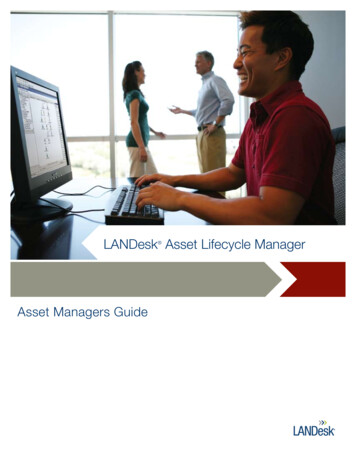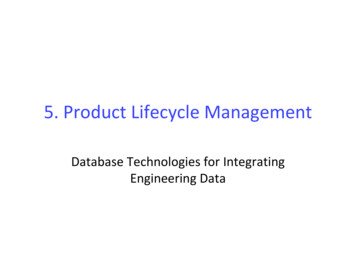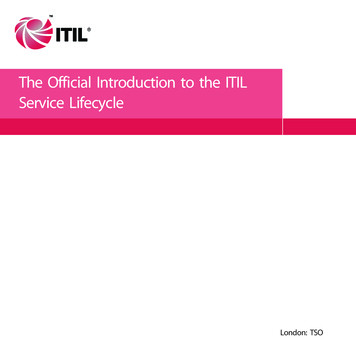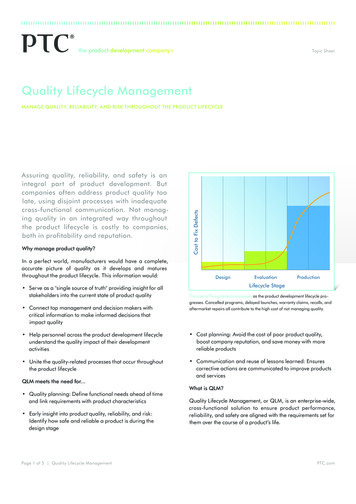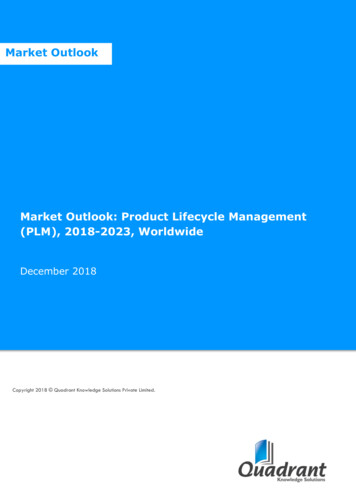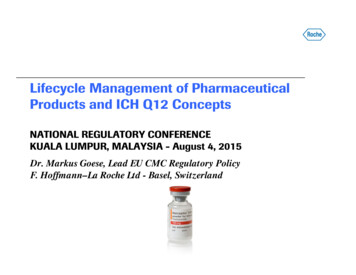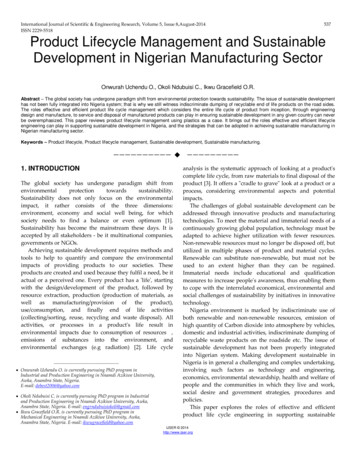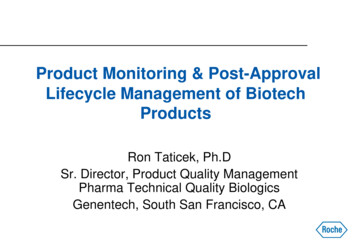
Transcription
Product Monitoring & Post-ApprovalLifecycle Management of BiotechProductsRon Taticek, Ph.DSr. Director, Product Quality ManagementPharma Technical Quality BiologicsGenentech, South San Francisco, CA
Presentation Outline Background – Need for integrated product quality management Process Monitoring and Data Trending – Roche/GenentechApproach Post-Approval Lifecycle Management Commercial Product Quality Steward role – Product qualityoversight by linking system, data, and people
Need for Integrated Product QualityManagementICH Q10 Pharmaceutical Quality System, Process Performance andProduct Quality Monitoring System 3.2.1: Pharmaceutical companies should plan and execute a system for the monitoring of process performance and product quality to ensure a state ofcontrol is maintained.Use quality risk management to establish the control strategy.Provide the tools (e.g., data management and statistical tools) formeasurement and analysis of parameters and attributes identified in the controlstrategyVerify continued operation within a state of controlIdentify sources of variation affecting process performance and product qualityfor potential continual improvement activities.Include feedback on product quality from both internal and external sources
Product Quality Management at Roche& Genentech An End to End view of product quality throughout the productand process lifecycle Strong scientific rigor and technical expertise used to evaluateproduct performance and consistency across sites A focus on innovation and continual improvement Ensures the safety, efficacy and purity of products producedand supplied to our patients
Product Quality Management: Fundamental ElementsProduct Complaints Early warning signals of product quality issues in thefieldProduct Assessment & Trending Proactive assessment of product qualityattributes across the manufacturing processProduct Quality Stewards Single point of Contact for Quality to key stakeholders Routine health assessment of product to address trends Planning provides foresight and proactive approachQC testing network support Harmonized approach to test method execution & support Scalability & flexibility to balance test workload across networkAnalytical methods management Scientific rigor engrained in analytical method performance Product control systems based on science Seamless product transfers & assessment of consistency 2009 Genentech, Inc.Slide 5
Benefits of Process Monitoring andTrending Meets regulatory expectations Proactively identifies and reduces variations in the testmethods and manufacturing processes Provides science and risk - based approach for CAPAactivities Ensures product consistency from site to site Ensures reliability of product supply and guarantees anefficient Supply Chain
Presentation Outline Background – Need for integrated product quality management Process Monitoring and Data Trending – Roche/GenentechApproach Post-Approval Lifecycle Management Commercial Product Quality Steward role – Product qualityoversight by linking system, data, and people
Process Monitoring and Data Trending:Roche/Genentech Approach Key elements in the continuous monitoring of commercialproducts Process and analytical life cycle validation Align inter-related inputs – process, methods, product quality attributes Definition of statistical state of control (control charts etc.) Examples of Data Trending Product Data Monitoring Analytical Method Monitoring Proper assessment of process capability consistent product quality
Life Cycle Approach to AnalyticalMethod Management Method development & qualification throughoutclinical stagesValidation Commercial method validation pre-licensure Commercial control system established at firstlaunch Analytical method transfer support commercialproduction globally On-going cross-site method monitoring ensuresstate of control throughout method and productlife ngTransferRoutineTesting
Product Quality Data Evaluation Dependent on both Analytical and Process Monitoring Proper assessment of manufacturing process capabilities relies onQC method performance assessment Product quality assessment, as measured by QC test methods,relies on assurance that analytical methods are consistent and arein a state of control
Fundamental Steps in Monitoring Establish statistical monitoring systems:–––––Appropriate monitoring attributesAppropriate statistical method (Control charts, Histogram, Pareto, etc.)Analyze data and establish trend/control limits from historical dataEstablish Rules for monitoring and trendingTimely evaluate of the impact of product and process changes Establish business process to assess out-of-trend (OOT) resultsand to assure that the process is in a state of statistical control Formal investigations and communication to stakeholdersrequired for OOT and Out-of-specification (OOS) event todetermine root cause (Discrepancy and CAPA)
Criteria for Monitoring Critical Quality Attributes (CQAs)Key QC test methodsCritical process parameters (CPP)Key process performance indicators (KPI)Periodic vs. real time monitoringSite versus global monitoring
Data Trending: Moving Range Chart Moving range chart – used1Individual V alue11111U C L 173.00170X 164.22160111150113252037496173Sample Number851971LC L 155.431109111M oving Rangeto track process variationand detect the presence of“special causes”. The moving range - equal todifference betweensuccessive pairs of numbersin a data set.I-MR Chart of Drug Substance111U C L 10.7910M R 3.300LC L 01132537496173Sample Number8597109
Examples of Process TrendChart: Process DataA set of random product data ispresented against the acceptancecriteria over a period of time: Top Histogram: A capable process(Centered & well- within processlimits) Middle histogram: Similar process(with lower mean) against the samelimits(Not centered or contained bylimits) Bottom histogram: Actual run chartdata for the top process14
Example of Integrating Process & Analytical MethodMonitoring Top: Product vs.reference materialdata trend chartdemonstrating arobust process Bottom: Product vs.reference materialdata trend chart for avariable process
Example of Process vs. AnalyticalMethod Capability Trend Chart Top graph shows acapable process Lower graph shows acapable QC methodthat supports theproduct specificationA Well behavedProcess & Method16
QC Method Monitoring Program Integral to the analytical method LCM Ensures that the method performance across complexmanufacturing network & testing sites is consistent Provide analytical trending support to process/product trendingAdditionally: A key component of the Annual Product Review (APR) –regulatory requirement by Health Canada Stability investigation support Serves as an inspection tool for analytical methods
Current Scope of Method MonitoringProgram Commercial biologicsAll QC testing sites including partners and CMOsIncorporates new sites after method transferCurrently focus on purity and potency methodsMonitor key quantitative attributesAnalysis of data from reference material, assay controls, andproduct controls
Monitoring Criteria and Data Based on available historical dataUse statistical analysisCross site harmonization of data submission formatCentralized group to perform trending analysis and report results
Examples of QC Method Monitoring ResultsTop: Reference Material data trendchart for all valid assays across 6 globaltesting sitesBottom: Site Mean trend chart for the 6sites showing that the methodperformance is consistent throughout allsitesMethod Monitoring limitsSystem suitability limitsA MAb product, Ion Exchange Method
Example: Method Monitoring Supports InspectionResponseA MAb product: Size Exclusion MethodData (n 1000) from 4 years and 5 sitesMean 99.8%SD 0.05RSD 0.05 Concern regarding lack of quantitative system suitability criteria for achromatography method Method monitoring provided strong evidence that method performance ina state of control, and sufficiently supporting release specification ( 98%)
Presentation Outline Background – Need for integrated product quality management Process Monitoring and Data Trending – Roche/GenentechApproach Post-Approval Lifecycle Management Commercial Product Quality Steward role – Product qualityoversight by linking system, data, and people
Post-Approval Lifecycle Management Process changes to improve yield Process changes to improve product quality Process monitoring/continual process verification Control system
Post-Approval Lifecycle Management: ProcessParametersChanges toCPPs or ProcesswithinDesign SpaceRangesSelf-ManagedNotify HealthAuthorities ofChange (byexception)Changes toCPPs or Processoutside ofDesign SpaceRangesChanges tonon-CPPsoutside of reportedMARs/ranges orChanges toNon-Critical StepsRequire Prior ApprovalReport perPre-NegotiatedAgreementSelf-ManagedNotify HealthAuthorities ofChange (byexception)Comparability Requirements Assessed via“Comparability Decision Tree” (if appropriate)
Post-Approval Lifecycle Management: ComparabilityDecision TreeIncreasing RiskNo Pre-Execution Product Comparability TestingConfirmation at Full Scale (1 lot)Control System TestingNo or limited KPI ComparabilityPre-Execution Product Comparability TestingConfirmation at Full Scale (1 lot)Control System CaM TestingKPI ComparabilityPre-Execution Product Comparability TestingConfirmation at Full Scale ( 1 lot)Control System More Extensive CaM TestingKPI ComparabilityAdditional Continuous Process MonitoringCaM Comparability and Monitoring Testinga May include stability testing of 1 or more full scale lots.
Post-Approval Lifecycle Management: PreNegotiated Change dardReportingCategoryChange covered by product-specificComparability Protocol (CP)Comparability Criteria filed in RegistrationDossier for existing multi-product ExpandedChange Protocol (eCP) covering changeChange not covered by either product-specificCP or existing multi-product eCPFile SubmissionPerPre-NegotiatedAgreementRequiresFDA PreApproval toImplement
Post-Approval Lifecycle Management: Changes tonon-CPPsChanges tonon-CPPs outside of reportedMARs/ranges or ProcessChange to Non-Critical StepRepeat Previous StudiesWith Expanded Rangesand/or Process ChangeAcceptable Result: MARsare extended &Results are available forReview at ComplianceAuditUnacceptable Result: Parameter(s)become CPPs & HA Notifiedof change to parameter classification& Design Space
Post-Approval Lifecycle Management: ContinuousProcess MonitoringRoutine ProcessMonitoringEveryRunEvery NthRun Done under a validationprotocolComparability Pre-defined acceptancecriteria for monitoring Frequency and durationindicatedFor Fixed Duration and Re-AssessControl System AssessmentPart of Control System (IP, Lot Release, Stability) Monitoring done usingvalidated or suitableassays
Post-Approval Lifecycle Management: ControlSystem Over the product lifecycle, the QA criticality and testing strategy will be reevaluated at a regular interval incorporating the following:––––new knowledge about the Quality Attributes gained from additional clinical, non-clinicaland characterization studiestrending of Quality Attributes from both the process (via IP, lot release, processmonitoring testing) and stability testingassay performanceavailability of new assays Re-evaluation could result in the change of criticality of a QA, the testing strategy(IP, lot release, stability, monitoring or none) and potentially, the assay used tomonitor the QA Any of these changes would be reportable and require prior-approval beforeimplementation Evaluation is done in response to out-of- trend results, as a result of the AnnualProduct Review (APR) process or every 5 years or as part of a significant processchange
Presentation Outline Background – Need for integrated product quality management Process Monitoring and Data Trending – Roche/GenentechApproach Post-Approval Lifecycle Management Commercial Product Quality Steward role – Product qualityoversight by linking system, data, and people
Commercial Supply Chain Teams:Product Steward ConceptPMTLPROPFinancePlanningQualityStewardPTTL DPPSCTPTTL DSCMCRegAQualityStewardLaunchSTL Dev CMCSTLAd Hoc Quality Sub Team MembersLotDispositionExternalQuality Change ControlProduct QualitySub-Team Methods Mgmt and Technology Inspection MgmtProductComplaints Compliance External QC ValidationInvestigationsStabilityQC IP/FP
Role of the Commercial ProductQuality StewardProduct Supply Chain Team Acts as the Voice of Quality (QA & QC) and provides Qualityexpertise and leadership on Product Supply Chain Team (PSCT) Serves as the communication conduit between PSCT and Qualityfunctional areas/departments Develops and manages the implementation of Quality-relatedactivities required to meet the product strategy and priorities Ensures Quality requirements are met during PSCT drivenactivities and changes
Role of the Commercial ProductQuality StewardProduct Quality Monitoring: Monitors and reports on product quality across the End-to-End(E2E) network Partners with Quality subject matter experts (SMEs) to resolveproduct quality issues to ensure no impact to patient/productsupply Conducts an annual Product Quality Risk Assessment; drivesresolution of identified risks Generates the monthly Product Quality Report Reviewers of Annual Product Review (APR)
Role of the Commercial ProductQuality StewardLifecycle Management Drive changes to ensure appropriate product quality life cyclemanagement spanning across the network, contract sites, andpartners Own and maintain the Process Specification File: Qualitycontrolled document that is a summary of current license rangesand commitments Accountable to ensure lifecycle commitments are completed Knowledge management Sharing of best practices
Conclusions Background – Need for integrated product quality management Process Monitoring and Data Trending – Roche/GenentechApproach Post-Approval Lifecycle Management Commercial Product Quality Steward role – Product qualityoversight by linking system, data, and people
Acknowledgements Deborah Baly Claudia Lin Gladys Sanders Dieter Schmalzing
Background –Need for integrated product quality management Process Monitoring and Data Trending –Roche/Genentech Approach Post-Approval Lifecycle Management Commercial Product Quality Steward role –Product quality oversight


